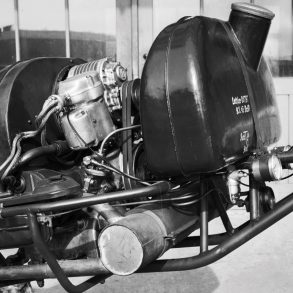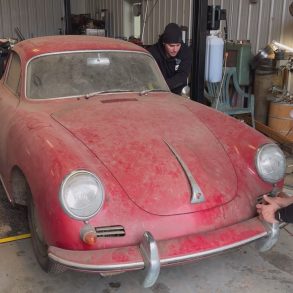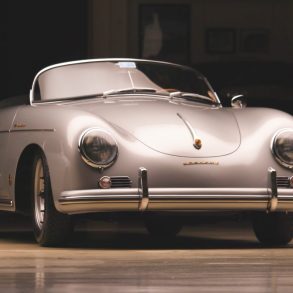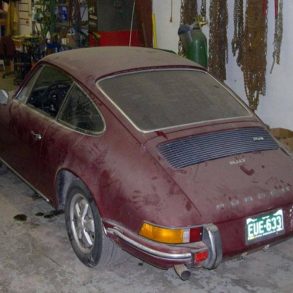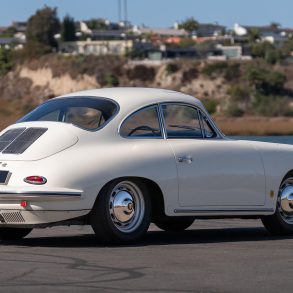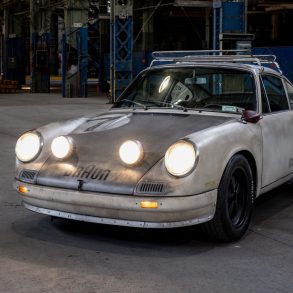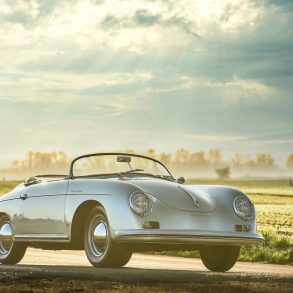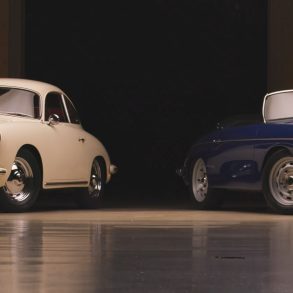The Audiobahn E8: Porsche in the 90’s
Welcome to The Audiobahn, the Stuttcars.com podcast focused on all things Porsche. In our first series, we’re exploring the history of venerable 911: its history, origins, achievements, and future.
The Audiobahn E8: Porsche in the 90’s
Read the Podcast Transcript
B: Good afternoon and welcome to the Audiobahn. I’m Brayden Clark, this is Chris Carnduff, and this is your Porsche podcast. On this podcast, we dive into the really well-written articles on stuttcars.com, pull out the great content, and turn them into these informative and hopefully entertaining podcast episodes. Over the past series we’ve been diving into the history of the 911, that iconic car. We’ve gone all the way back from the 356, and we’re gonna go all the way up until modern day. In the previous episode we talked about…
C: We talked about the late 80s and the introduction of the 964 911.
B: And this episode, in fact two episodes, because this is a joint thing. We’re going to be diving into the early years of the 90s where Porsche was pumping out a whole bunch of cars. There’s a lot going on in there. Yeah, it’s gonna be a fun episode.
C: Yeah, it’s gonna be a very interesting pair of episodes. Porsche is a well, we’ll get into that.
B: So there’s gonna be two episodes. Are you ready?
C: I’m ready, are you ready?
B: I’m ready. let’s go.
In this episode we are talking about the 964 and all the different 964s because there were a lot of them in the early 90s. Chris, take us away please.
C: All right so after the 964 Carrera 4 was introduced, which effectively solved the oversteering Tendencies of the previous generation, which is no minor miracle, a rear wheel drive version called the Carrera 2 was added six months later. Get it? Because it’s only got two wheels driving where as the Carrera 4 had all-wheel drive. That was about it. The car was largely the same otherwise. Would you be able to give us some quick stats on the Carrera 4?
B: I would happily give us some quick stats. For the Carrera 4 we have a 3.6 liter engine generating 250 brake-horsepower at 6,100 RPM and 229 pound-feet of torque at 4,800 RPM. That’s going to give you a top speed of 162 MPH and a 0-60 of 5.6 seconds in something with a weight of 3,252 pounds. That’s for the Carrera 4. For the Carrera 2, you’ve got two variants. You’ve got the manual and the Tiptronic. They both have the same 3.6 liter engine and they both generate 250 brake-horsepower at 6,100 RPM and 229 pound-feet of torque. I keep wanting to say fork.
C: No spoons involved.
B: No spoons involved. At 4800 RPM and giving you a top speed of 162 MPH for the manual and 159 MPH in the Tiptronic and a 0-60 of 5.5 seconds in the manual and 6.4 seconds, so a good deal longer in the Tiptronic. And the weight difference between the two of them is about 70 pounds. So 3,031 pounds for the manual and 3,100 pounds flat for the Tiptronic.
C: Yeah, what I really like about this car in particular is because of the addition of the triptronic, automatic transmission that was coming into these, you start being able to see the different variations of power and how fast the car can actually go and how fast it gets to 60. You know, race car driving is an awful lot like sex, Brayden. Every man thinks that he’s great.
B: I was not.. all right, go on.
C: Okay, so whenever you see a manual transmission number of a 0 to 60 to 5.5 seconds.
B: That’s assuming a good driver.
C: Yeah that assumes that their left foot and their right hand are in sync with their left foot and their left-handed their right foot. I can’t even think about which hand and which foot I’m talking about, so I would probably not be able to go 0 to 60 in 5.5 seconds. So the triptronic takes a lot of the guesswork out. We’re getting to that stage in the early 90s where for the first ever time, an automatic transmission was faster than a manual transmission was in the Coronet during the 60s. That was an American car. But we can start seeing that towards the 90s and beyond, automatic transmissions are really going to start catching up, despite their weight because weight is still one of the biggest issues with having an automatic over a manual at this point. But that’s not going to be a problem for us in 10 years after this point. But let’s park that conversation for now. So now there is effectively a base model for this new generation with a Carrera 2 and the Carrera. We get to talk about, now, all the other 964 911s that came out because there were so many.
B: There were so many.
C: So many for a generation that lasted five years,there is a ridiculous amount. In addition to the base model, Carrera Coupe, which we just talked about, there is also the Cabriolet and the Targa versions, which were pretty well exactly the same except for heavier because the thing that happens whenever you take a roof off a car is…
B: You need more structural support elsewhere.
C: You got it. The car gets heavier, so it gets a little bit slower, but it’s the same car largely. So in the 1990’s, Porsche 911 offerings also included the type 964 turbo option and when first introduced in March of 1990 the 911 Turbo initially featured a turbocharged 3.3 liter boxer engine that was carried over, with updates, from the previous 911 Turbo models, albeit with reduced turbo lag, because the biggest thing holding back turbo’s is how fast they can spool up. Would you be able to give us some quick stats on the turbo models?
B: Happily. Let me just clear the coffee out of my throat.
C: Could you specifically give us the 1990 Turbo.
B: Yes, just the 1990 911 Turbo with it’s 3.3 liter engine was making a fantastic 300 brake-horsepower at 5,500 RPM and generating 317 pound-feet of torque at 4,000 RPM. So it’s giving us a top speed of 159 MPH and a 1 to 60 or 0 to 60 of 5.1 seconds. So faster off the line, slower top speed, and obviously this low top speed is probably down to the fact that it weighs 3,214 pounds. It’s a heavier machine.
C: It is, yeah.It’s certainly heavier.
B: Was there anything else limiting that top speed or did it mainly come down to the weight?
C: I think it mainly comes down to the weight and the Power Band changes with an engine like that. Something that I always find plenty of fun to look at, whenever looking at any of these cars, is to see the compression ratio. Which we actually don’t have written down here, but if you look at the turbo models, the compression ratio on this car was like seven to one. To put that into perspective, the 305 in my Caprice Classic is running eight and a half to one compression, which is a pretty low compression, V8 engine. Seven to one is super low, but that’s what Turbo Charge turbochargers need is super low compression. Compare that to the other 964s that are running 11 to 1 compression at this time, which is really high, it’s high enough that you’re gonna start… we already know you’re using premium fuel at this point with Porsches, you have a high octane number because you’re trying to retard that combustion until just the right moment.You get much higher than 11 to 1 and you start having to talk about really high octanes. You start kind of thinking about oh well maybe I should put some octane additive into this, because you just have to worry about that kind of thing.So I think that’s more or less the limiting factor. The power band that you’re going to find in a turbo engine is different because of the compression, just because of the speeds that it’s spinning at. You have to worry about how fast the turbo is spinning, you have to worry about critical mass, there is a point of diminishing returns on every Power Band and on turbos that does look a lot different than on a naturally aspirated engine.
B: That makes sense.
C: So in 1992, so that was the 99 that was the 1990. Iimportantly, that was the previous turbo engine in the new 964 body and built right and the 964 body and the 930 body is totally different, the car is wildly different from each other so using the previous engine in that was akin to what happened with the 356 and the 901. Or the 912. When we had the super 90 engine just being tossed into a 911 body and hey there we go we have the 912. That’s kind of what’s happening with this turbo model.
B: It’s almost a transitionary or hybrid kind of. Not hybrid because that’s completely different connotations, they didn’t have that then. But that makes sense.
C: Exactly, so there was a lot of pressure for Porsche to go and actually make a 964 turbo. So in 1991 they kind of put that together and what ends up happening in 1992 with the Porsche 911 Turbo was that it had a much upgraded engine, so instead of having 3.3, it now had the 3.6 liter engine that was delivering more power. Would you mind telling us?
B: I will Happily do that. This is for the 1992 911 Turbo. Also with a 3.3 liter engine, creating 320 brake-horsepower at 5,750 RPM and 332 pound-feet of torque at 4,500 RPM it gave us a top speed of 168 MPH and a 0-60 of 5.4 seconds and something that weighed a little bit more, so 3,274 pounds compared to the 3,214 pounds, so 60 pounds heavier.
C: Yeah, that’s it. And it is going faster.
B: You got 90 miles an hour top speed on top of it.
C: If you’re even getting that fast. We don’t have the Auto Bond in North America.
B: But we do have the Audiobahn. Selfish plug. You can’t buy these mugs but you can buy Porsche mugs. Go on. Shameless plug.
C: Only $35 a year.
B: $35 a year for the mug and it comes with a free membership. That’s not true. Okay so that’s the 1992.
C: That’s the 1992 model year. At the end of the 964 production in 1994, the Porsche Factory had some 90 turbo chassis that they had left over and they gave them the Porsche exclusive treatment to create a very special turbo 3.6 S model that ended up having 380 horsepower. The turbos kind of build on top of each other during this time, but notably there’s an 80 horsepower difference from the beginning of the generation to the end of the generation. This is also the 90s, we have a ton of technological changes that are happening and Porsche adds that 80 horsepower. That’s not all that they were doing with it. So now that we have the Carrera 2, 4 and the turbos out of the way, here comes the special editions. Several other special edition 964s were made and they are some of the most sought after cars in the classic car market today, especially if you’re into Porsche. My goodness I remember I had a teacher in high school who had one of these and he was so proud of it.
B: What subject did this teacher teach?
C: He was the band teacher teacher. I got to talk with him a lot about it. I remember tell him I’m into cars and he’s like oh man you should see my Porsche and he’s talking about how special of a color it was and everything. I don’t quite get this yet but one day.
B: Well now, now in hindsight. It’s like it was really special. So what drugs was he selling to afford a Porsche as a band teacher? I know how much musicians make.
C: His drug was being an internationally recognized adjudicator for marching bands.
B: Yeah, that’ll do it.
C: Anyways. In 1992 there was a plethora of special editions, including the American Roadster, which was just essentially a turbo body capriolet and we’re going to hear a lot of stuff like. It had the Standard Electric spoiler and the Turbo guards and mechanically was exactly the same as the standard model apart from the 17-inch cup wheels and the brakes and the suspension. Only 250 of this variant were ever produced. There were also Porsche 964 speedsters which came in two distinct incarnations. The first was the 1989 model year Speedster which was basically a 930 Turbo under the covers. But the true 964 Speedster was the 1994 Speedster which was based on the 964 Carrera 2 platform. More than three quarters or 641 exactly of the 800 that were built had the turbo look wide-body option and Porsche planned to build 3,000 of these cars. But in 1994, speedsters in 1992 they plan to build 3,000 of them, they only ever made 936.
B: Why?
C: We’re going to get into that
B: Was that intentional just to land it on the 936. Or was that coincidence?
C: Completely coincidental. So you said why is that? Which is a great question. Not to get into spoilers too much for next episode, but the 80s were not kind to the American dollar and the early 90s were a time of baited anticipation and perhaps recovery, which didn’t come for some time and Porsche was linked to the economics of America and I think in ways that they would have preferred they weren’t. But we’re going to talk about that more next episode. Something else we’re going to talk about next episode is that in 1992 Porsche produced a super lightweight version of the rear wheel drive only version of the 964 and they dubbed this the Carrera RS and it was for the European market exclusively, using their Carrera Cup race car as the base. And you can tune in next week for when we go over those quick stat blocks and we talk about why Porsche was the way that they were during the early 90s and why this generation only lasted for those five years.
B: We don’t just dive into the mechanical stuff, we’re also diving slightly into the economic impact that they had in being in the states.
C: We get to do the Deep dive and look at some specialty articles that are on Stuttcars.com which link up with this really really well. We’re going to talk about stuff that’s behind the paywall now.
B: Don’t don’t tell the bosses, they’ll kill us. But we’re gonna do it.
C: Get that get that five dollars in. Click on the link for next episode for this article because we’re going to cover some of it, but let me tell you it’s a doozy of a read and it is wildly fascinating and you really cannot find this information anywhere else.
B: Awesome.
Okay, well guys that was our initial look at the 964 in the early 90s of Porsche. There’s so many different models and variants going on in that time period. Next episode we’re going to dive into it even more and look at the politics of what’s going on within Porsche. I know we’ve got some really cool exclusive interviews with an ex-ceo and we’re gonna look at the economy and how it really affected Porsche in general. So that was fun. Thank you, Chris.
C: Thank you. Go thank yourself.
B: I feel both offended and thanked.
C:And thank you dear viewers.
B: Again, thank you guys for joining us. If you want to learn more about any of the cars we’re talking about, we do include links and references to all the different articles on struttcars.com and if you want to learn more about Porsche and Porsche history and even modern Porsche news, go to stuttcars.com. It’s one of the best places to learn about Porsche. They’ve got really well-written articles and just some of the most amazing exclusive interviews and feature pieces. They’ve also got a really good five dollar a month membership or $35 for a whole year. It gives you access to articles that no one else can read that are just mind-blowingly unique. Stuff that you can almost find nowhere else in the world. So head over to stuttcars.com, grab a membership, we do have Porsche mugs and t-shirts and all that fun stuff. But in the meantime, for myself Brayden, and Chris, have an awesome time and we’ll see you later.


